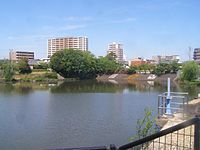Ōbu
Ōbu
大府市 | |
|---|---|
 Aichi Health Village Park | |
 Location of Ōbu in Aichi Prefecture | |
| Coordinates: 35°00′42″N 136°57′49.2″E / 35.01167°N 136.963667°E | |
| Country | Japan |
| Region | Chūbu (Tōkai) |
| Prefecture | Aichi |
| Government | |
| • Mayor | Takayasu Kuno |
| Area | |
| • Total | 33.66 km2 (13.00 sq mi) |
| Population (October 1, 2019) | |
| • Total | 92,179 |
| • Density | 2,700/km2 (7,100/sq mi) |
| Time zone | UTC+9 (Japan Standard Time) |
| Phone number | 0562-47-2111 |
| Address | 5-70 Chūō-chō, Ōbu-shi, Aichi-ken 474-8701 |
| Climate | Cfa |
| Website | Official website |
| Symbols | |
| Flower | Gardenia |
| Tree | Holly |
Ōbu (大府市, Ōbu-shi) is a city located in Aichi Prefecture, Japan. As of 1 October 2019[update], the city had an estimated population of 92,179 in 39,382 households,[1] and a population density of 2,739 persons per km2. The total area of the city is 33.66 square kilometres (13.00 sq mi). Ōbu has been a member of the World Health Organization’s Alliance for Healthy Cities (AFHC)[2] since June 5, 2000.
Geography
[edit]
Ōbu is located in the far northeastern neck of Chita Peninsula in southern Aichi Prefecture, and is bordered by the metropolis of Nagoya to the north.
Climate
[edit]The city has a climate characterized by hot and humid summers, and relatively mild winters (Köppen climate classification Cfa). The average annual temperature in Ōbu is 16.6 °C (61.9 °F). The average annual rainfall is 1,506.0 mm (59.29 in) with October as the wettest month. The temperatures are highest on average in August, at around 28.7 °C (83.7 °F), and lowest in January, at around 5.3 °C (41.5 °F).[3]
| Climate data for Ōbu (2012−2020 normals, extremes 2012−present) | |||||||||||||
|---|---|---|---|---|---|---|---|---|---|---|---|---|---|
| Month | Jan | Feb | Mar | Apr | May | Jun | Jul | Aug | Sep | Oct | Nov | Dec | Year |
| Record high °C (°F) | 18.2 (64.8) |
22.4 (72.3) |
24.8 (76.6) |
28.8 (83.8) |
33.4 (92.1) |
34.3 (93.7) |
38.8 (101.8) |
38.9 (102.0) |
36.9 (98.4) |
31.8 (89.2) |
25.0 (77.0) |
23.8 (74.8) |
38.9 (102.0) |
| Mean daily maximum °C (°F) | 9.5 (49.1) |
10.4 (50.7) |
15.2 (59.4) |
19.8 (67.6) |
25.4 (77.7) |
27.7 (81.9) |
31.5 (88.7) |
33.6 (92.5) |
29.1 (84.4) |
23.6 (74.5) |
17.6 (63.7) |
11.6 (52.9) |
21.2 (70.3) |
| Daily mean °C (°F) | 5.3 (41.5) |
5.9 (42.6) |
10.0 (50.0) |
14.8 (58.6) |
20.0 (68.0) |
23.1 (73.6) |
27.1 (80.8) |
28.7 (83.7) |
24.5 (76.1) |
19.1 (66.4) |
13.0 (55.4) |
7.4 (45.3) |
16.6 (61.8) |
| Mean daily minimum °C (°F) | 1.1 (34.0) |
1.8 (35.2) |
5.2 (41.4) |
9.9 (49.8) |
14.9 (58.8) |
19.3 (66.7) |
23.8 (74.8) |
25.0 (77.0) |
20.9 (69.6) |
15.3 (59.5) |
8.6 (47.5) |
3.2 (37.8) |
12.4 (54.3) |
| Record low °C (°F) | −4.7 (23.5) |
−4.3 (24.3) |
−1.6 (29.1) |
2.7 (36.9) |
6.2 (43.2) |
12.8 (55.0) |
18.7 (65.7) |
19.5 (67.1) |
12.1 (53.8) |
6.6 (43.9) |
−0.6 (30.9) |
−3.3 (26.1) |
−4.7 (23.5) |
| Average precipitation mm (inches) | 53.3 (2.10) |
56.3 (2.22) |
113.8 (4.48) |
141.1 (5.56) |
128.5 (5.06) |
164.0 (6.46) |
177.9 (7.00) |
141.4 (5.57) |
186.7 (7.35) |
222.7 (8.77) |
61.8 (2.43) |
65.4 (2.57) |
1,506 (59.29) |
| Average precipitation days (≥ 1.0 mm) | 5.6 | 5.8 | 8.6 | 8.6 | 8.3 | 11.3 | 11.0 | 8.3 | 10.5 | 9.6 | 6.4 | 6.8 | 100.8 |
| Mean monthly sunshine hours | 187.1 | 174.6 | 210.0 | 204.3 | 239.4 | 168.6 | 176.1 | 224.7 | 154.8 | 158.1 | 169.1 | 165.5 | 2,234.3 |
| Source: Japan Meteorological Agency[4][3] | |||||||||||||
Demographics
[edit]Per Japanese census data,[5] the population of Ōbu has been increasing steadily over the past 70 years.
| Year | Pop. | ±% |
|---|---|---|
| 1940 | 13,967 | — |
| 1950 | 20,427 | +46.3% |
| 1960 | 26,137 | +28.0% |
| 1970 | 48,960 | +87.3% |
| 1980 | 62,277 | +27.2% |
| 1990 | 69,720 | +12.0% |
| 2000 | 75,273 | +8.0% |
| 2010 | 85,254 | +13.3% |
Neighboring municipalities
[edit]History
[edit]Late modern period
[edit]The village of Ōbu was established within Chita District, Aichi on October 1, 1889, with the establishment of the modern municipalities system. On May 1, 1906, Ōbu annexed the neighboring villages of Yoshida, Kyowa, Kitasaka, Yokote, Nagagusa and part of the village of Morioka. It was elevated to town status on November 1, 1915.
Contemporary history
[edit]Ōbu became a city on September 1, 1970.
Government
[edit]
Ōbu has a mayor-council form of government with a directly elected mayor and a unicameral city legislature of 19 members. The city contributes one member to the Aichi Prefectural Assembly. In terms of national politics, the city is part of Aichi District 7 of the lower house of the Diet of Japan.
Sister cities
[edit] Port Phillip, Victoria, Australia, since November 20, 1993[6]
Port Phillip, Victoria, Australia, since November 20, 1993[6]
Economy
[edit]Tertiary sector
[edit]Commerce
[edit]Ōbu has a mixed economic base due to its proximity to the Nagoya metropolis and numerous transportation connections.
Education
[edit]
University
[edit]- Shigakkan University
- University of Human Environments, Ōbu campus
Schools
[edit]- Ōbu has nine public elementary schools and four public junior high schools operated by the city government, and three public high schools operated by the Aichi Prefectural Board of Education.
Transportation
[edit]

Railways
[edit]Conventional lines
[edit]- Tōkaidō Main Line: - Ōbu - Kyōwa -
- Taketoyo Line: Ōbu -
Roads
[edit]Expressways
[edit]Japan National Route
[edit]Notable people from Ōbu
[edit]- Kumiko Koiwai, figure skater
- Masayoshi Nagata, mathematician
- Takahiro Nakai, Judoka
- Kyoko Takezawa, violinist
- Hidehiko Yoshida, Olympic gold-medalist judoka
References
[edit]- ^ Ōbu City official statistics (in Japanese)
- ^ Alliance for Healthy Cities official home page
- ^ a b 気象庁 / 平年値(年・月ごとの値). JMA. Retrieved April 13, 2022.
- ^ 観測史上1~10位の値(年間を通じての値). JMA. Retrieved April 13, 2022.
- ^ Ōbu population statistics
- ^ "International Exchange". List of Affiliation Partners within Prefectures. Council of Local Authorities for International Relations (CLAIR). Retrieved 21 November 2015.
External links
[edit]![]() Media related to Ōbu, Aichi at Wikimedia Commons
Media related to Ōbu, Aichi at Wikimedia Commons
- Official website (in Japanese) (with link to pages in English)
- Sister Cities by the Sea - information on the relationship between Obu and Port Phillip (English and Japanese content).



